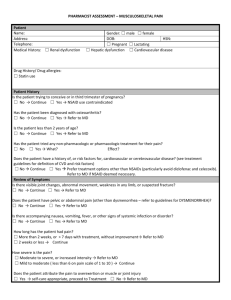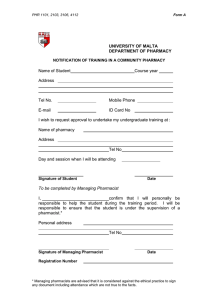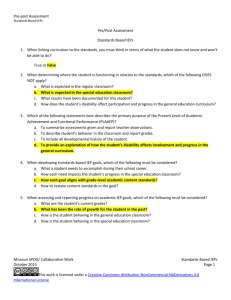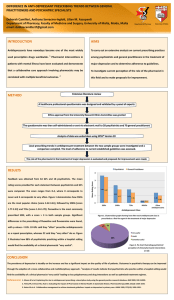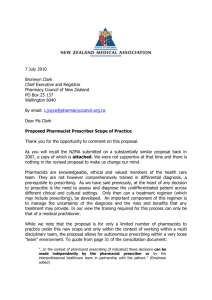Risks in Pharmacist Prescribing Guidelines INTRODUCTION
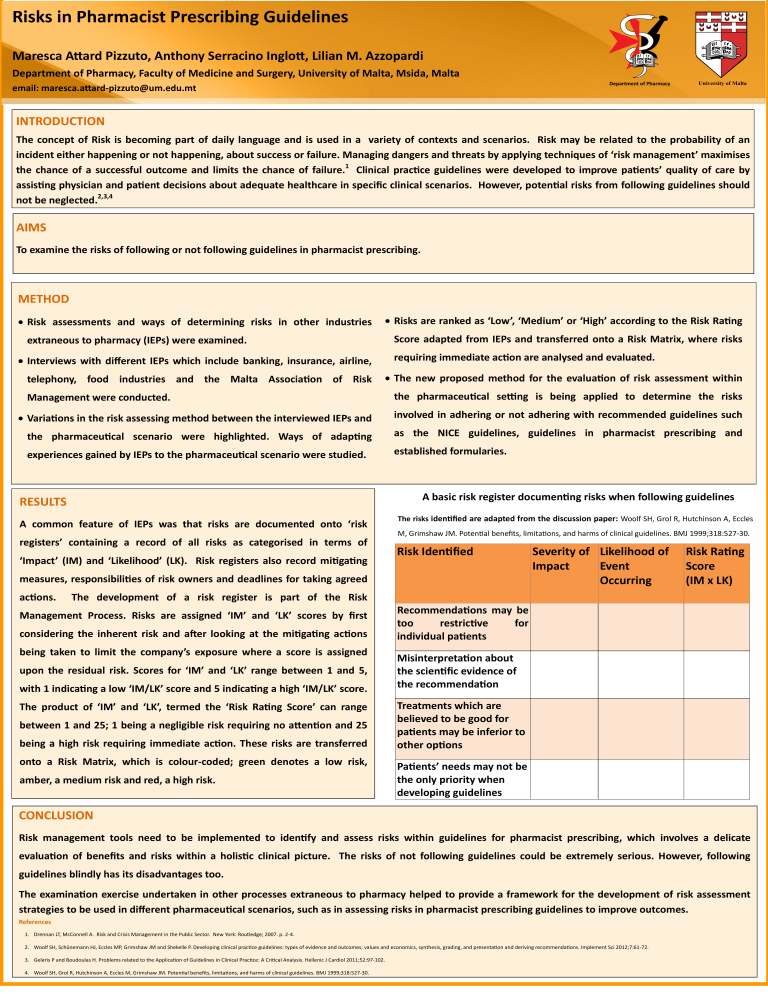
DEPARTMENT OF PHARM
TY OF MALTA
Risks in Pharmacist Prescribing Guidelines
Maresca Attard Pizzuto, Anthony Serracino Inglott, Lilian M. Azzopardi
Department of Pharmacy, Faculty of Medicine and Surgery, University of Malta, Msida, Malta
email: maresca.attard-pizzuto@um.edu.mt
Department of Pharmacy
University of Malta
INTRODUCTION
The concept of Risk is becoming part of daily language and is used in a variety of contexts and scenarios. Risk may be related to the probability of an incident either happening or not happening, about success or failure. Managing dangers and threats by applying techniques of ‘risk management’ maximises the chance of a successful outcome and limits the chance of failure.
1
Clinical practice guidelines were developed to improve patients’ quality of care by assisting physician and patient decisions about adequate healthcare in specific clinical scenarios. However, potential risks from following guidelines should not be neglected.
2,3,4
AIMS
To examine the risks of following or not following guidelines in pharmacist prescribing.
METHOD
Risk assessments and ways of determining risks in other industries extraneous to pharmacy (IEPs) were examined.
Interviews with different IEPs which include banking, insurance, airline, telephony, food industries and the Malta Association of Risk
Management were conducted.
Variations in the risk assessing method between the interviewed IEPs and the pharmaceutical scenario were highlighted. Ways of adapting experiences gained by IEPs to the pharmaceutical scenario were studied.
Risks are ranked as ‘Low’, ‘Medium’ or ‘High’ according to the Risk Rating
Score adapted from IEPs and transferred onto a Risk Matrix, where risks requiring immediate action are analysed and evaluated.
The new proposed method for the evaluation of risk assessment within the pharmaceutical setting is being applied to determine the risks involved in adhering or not adhering with recommended guidelines such as the NICE guidelines, guidelines in pharmacist prescribing and established formularies.
RESULTS
A common feature of IEPs was that risks are documented onto ‘risk registers’ containing a record of all risks as categorised in terms of
‘Impact’ (IM) and ‘Likelihood’ (LK). Risk registers also record mitigating measures, responsibilities of risk owners and deadlines for taking agreed actions. The development of a risk register is part of the Risk
Management Process. Risks are assigned ‘IM’ and ‘LK’ scores by first considering the inherent risk and after looking at the mitigating actions being taken to limit the company’s exposure where a score is assigned upon the residual risk. Scores for ‘IM’ and ‘LK’ range between 1 and 5, with 1 indicating a low ‘IM/LK’ score and 5 indicating a high ‘IM/LK’ score.
The product of ‘IM’ and ‘LK’, termed the ‘Risk Rating Score’ can range between 1 and 25; 1 being a negligible risk requiring no attention and 25 being a high risk requiring immediate action. These risks are transferred onto a Risk Matrix, which is colour-coded; green denotes a low risk, amber, a medium risk and red, a high risk.
CONCLUSION
A basic risk register documenting risks when following guidelines
The risks identified are adapted from the discussion paper: Woolf SH, Grol R, Hutchinson A, Eccles
M, Grimshaw JM. Potential benefits, limitations, and harms of clinical guidelines. BMJ 1999;318:527-30.
Risk Identified Severity of
Impact
Likelihood of
Event
Occurring
Risk Rating
Score
(IM x LK)
Recommendations may be too restrictive for individual patients
Misinterpretation about the scientific evidence of the recommendation
Treatments which are believed to be good for patients may be inferior to other options
Patients’ needs may not be the only priority when developing guidelines
Risk management tools need to be implemented to identify and assess risks within guidelines for pharmacist prescribing, which involves a delicate evaluation of benefits and risks within a holistic clinical picture. The risks of not following guidelines could be extremely serious. However, following guidelines blindly has its disadvantages too.
The examination exercise undertaken in other processes extraneous to pharmacy helped to provide a framework for the development of risk assessment strategies to be used in different pharmaceutical scenarios, such as in assessing risks in pharmacist prescribing guidelines to improve outcomes.
References
1. Drennan LT, McConnell A. Risk and Crisis Management in the Public Sector. New York: Routledge; 2007. p. 2-4.
2. Woolf SH, Sch ü nemann HJ, Eccles MP, Grimshaw JM and Shekelle P. Developing clinical practice guidelines: types of evidence and outcomes; values and economics, synthesis, grading, and presentation and deriving recommendations. Implement Sci 2012;7:61-72.
3. Geleris P and Boudoulas H. Problems related to the Application of Guidelines in Clinical Practice: A Critical Analysis. Hellenic J Cardiol 2011;52:97-102.
4. Woolf SH, Grol R, Hutchinson A, Eccles M, Grimshaw JM. Potential benefits, limitations, and harms of clinical guidelines. BMJ 1999;318:527-30.
